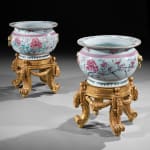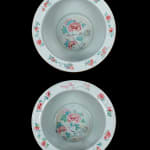A PAIR OF CHINESE EXPORT FAMILLE ROSE FISH BOWLS
D: 24” / 57cm
Further images
Provenance
Mrs. Maria da Conceição (São) Schlumberger (1929-2007)
The Chinese Porcelain Company, New York
Literature
George C. Williamson, The Book of Famille Rose, Tokyo, 1970, pl. LIII
Patricia F. Ferguson, Ceramics: 400 Years of British Collecting in 100 Masterpieces (London: 2016)
A pair of Chinese Qing Dynasty, Yongzheng period famille-rose fish bowls, each potted with a wide bulbous body rising to an everted lip, set with applied biscuit lion mask handles; the exterior painted brightly with birds and blossoming peonies, roses, magnolias and chrysanthemums, all below a narrow band depicting sinuous chilongs prowling and grasping lingzhi; the interiors decorated with further floral blooms; standing on later carved and gilded stands.
These fish bowls was likely made in the Chinese city of Jingdezhen in the province of Jiangxi. Painted in fencai or famille rose enamels, however, they were likely decorated in workshops in Guangzhou (Canton), Guangdong province, which catered to the export market.
Vessels of this type were usually intended for use as fish bowls and thus painted in the interior with fish among water plants. The present pair is unusual in depicting flowers and birds inside, which suggests that it might have been intended for other purposes in a European setting, perhaps as jardinières or wine coolers.
Fishbowls of this form, decorated with fish and aquatic plants in the interior, belonged to the imposing décor of European palaces such the Royal Palace in Stockholm, where a pair, with similar peony decoration, is in the ballroom (The White Sea Hall) in the state apartments. Another pair is in the state apartments of the Royal Palace in Turin.
The present pair compares closely to a very fine example at Wallington House, Northumberland (Figure 1), described as a ‘noble china cistern’ by the agriculturalist and social observer Arthur Young when he visited Wallington in 1769. This bowl is similarly painted on the outside with peonies and birds and rockwork and features carrying handles of identical form and construction.
Another fishbowl depicting butterflies and flowers between the rim and the upper decorative band, is in the collection of Sir Philip Sassoon and is illustrated in George C. Williamson, The Book of Famille Rose, Tokyo, 1970, pl. LIII and a further example at Blickling Hall, Norfolk also compares closely.
The bowls’ shape, which first appeared in Chinese porcelain in the 1720s, closely resembled seventeenth-century archaistic censers (‘gui’). An inscription on an example dated 1734 identifies it as an incense burner. This pair has lion’s head masks of Buddhistic origin made of unglazed porcelain, dressed in brown slip and gilt to resemble bronze. They are fitted with gilt-metal drop-ring handles for ease of transport. The decoration in ‘fencai’, or ‘famille rose’, enamels depicts tree peonies and birds, possibly executed at workshops in Guangdong (Canton) catering to the export trade. The interior being painted with more peonies rather than fish is further evidence that they were intended for export and use in a European setting, perhaps as jardinières or wine coolers, as opposed to fish bowls.
Goldfish were first recorded in England in 1691 but were routinely imported from China as private trade only from the 1730s, perhaps influenced by descriptions of the goldfish kept as pets by Chinese courtiers. The naturalist George Edwards noted that Charles Lennox, 2nd Duke of Richmond (1701-50), of Goodwood, Sussex, had a ‘large Chinese earthen Vessel full of these Fish brought to England’ and Horace Walpole famously bred goldfish at Strawberry Hill, Twickenham, as gifts for friends. The Goodwood bowls (Figure 2) remain in situ and compare closely to the present pair.
Bowls such as these were soon adapted as cisterns for rinsing drinking glasses or chilling wine bottles. This use was no doubt suggested by their similarity to European metalware cisterns, also fitted with drop ring handles, and English porcelain cisterns which usually acquired in pairs and fitted with ornamental stands, as supplied by Thomas Chippendale in the 1770s to two Yorkshire houses, Nostell Priory and Harewood House.
By the early nineteenth-century, as abstainers from alcohol now, the Trevelyans, to whom Wallington passed in 1777, converted the Wallington cistern into a jardinière. Nineteenth-century paintings of the Saloon show it planted first with sand lilies (Veltheimia capensis) and then, in 1853, with calla lilies (Zantedeschia aethiopica). In the 1920s it was once again filled with water to ‘make the fish come alive’ and entertain the Trevelyan children. This reveals the diverse functions which these bowls were employed to perform.
SCHLUMBERGER
São Schlumberger (1929-2007) was the Portuguese born wife of oil-magnate Pierre Schlumberger (1914-1986), and together they are known for their unshakeable support for pioneering artists and profound enthusiasm for a wide array of artistic innovation, which positioned them at the vanguard amongst the leading patrons of the arts in the second half of the twentieth century.
Having an unparalleled place at the head of both the French and American high societies, and beyond their continued financial support of various artists and institutions, the Schlumberger’s Hôtel de Luzy on the rue Férou was one of the Paris’ grandest salons, designed in an audacious mélange of contemporary and classical extravagance by Pierre Barde, Valerian Rybar and Daigres.
Attracted by their theatrical effect, Mrs. Schlumberger owned several pairs of Chinese porcelain fish bowls, and one pair with a different pattern from this pair, is visible in the photograph of her extravagant salon in her apartment in Avenue Charles Floquet by Eric Bowman (published in Vanity Fair, The Wow of São, October 2010).





